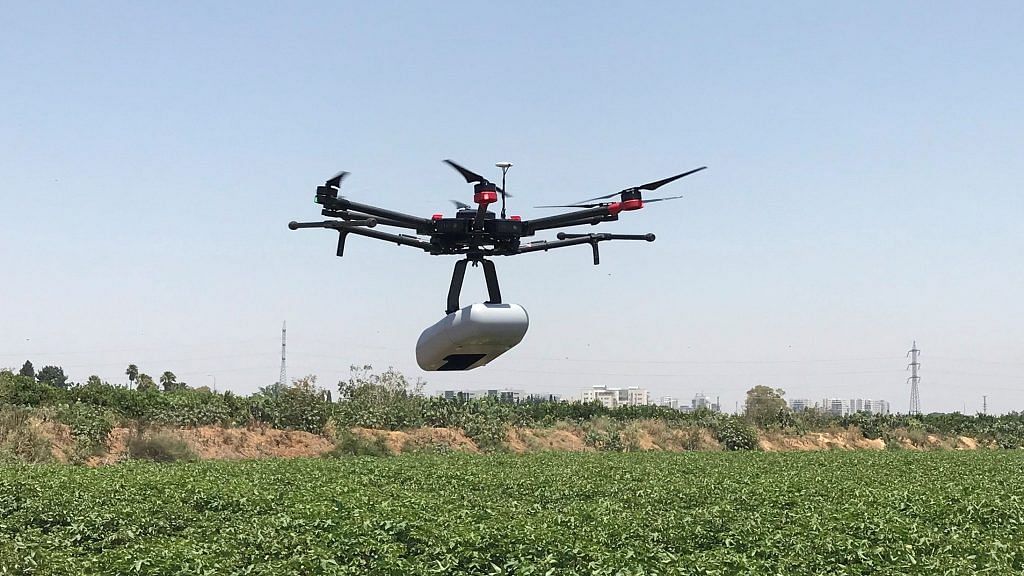As we reach closer in the quest for an effective Covid-19 vaccine, with Pfizer, Moderna and Oxford AstraZeneca announcing more than 90 per cent efficacy, governments around the world, including in India, are getting ready for mass vaccination programmes. The Narendra Modi government expects the Oxford-AstraZeneca’s Covishield and Bharat Biotech’s Covaxin to be available by January 2021 and four more vaccines by the end of April. The main challenge, however, would be in delivering the vaccine to every corner of the country – to the last mile.
India has a well-laid vaccination delivery system owing to its universal immunisation programmes. But in the case of Covid-19, it will be a mammoth task. India can rely on its one of the world’s largest railways and road networks, but looking at the enormity of the situation and the country’s topography, a new, efficient method of transporting vaccines would be required. This is where the drone-based distribution system comes in.
Since late 2018, countries have started deploying drones to deliver vaccines – the small Pacific island nation of Vanuatu was the first one to do it. In 2019, Ghana started off one of the largest drone delivery vaccine networks in the world. The service operates 24-hours a day all week with a force of 30 drones serving nearly 12 million people of the country. During the Covid-19 crisis, drones also carried testing kits across Ghana. In Rwanda, drones are supplying blood and medical supplies to several locations across the country. At present, drones carry more than 35 per cent of Rwanda’s national blood transfusion service supply through a network of 21 remotely located clinics.
Also read: What India’s military commentators don’t get about drones — AI can’t just be unboxed and used
Sporadic use of drones in India
There are instances of drone usage in emergency situations in India as well. The National Disaster Management Authority (NDMA) used drones during the Uttarakhand floods in 2013, and again during Kerala floods in 2018. In 2019, during the forest fires at Bandipur in Karnataka, the forest department administered drones to tackle the situation. Unmanned Aerial Vehicles (UAVs) have been used by the Indian armed forces on many occasions – during avalanches in the Siachen region, terrorist attacks at Pulwama and Uri, counter-insurgency operations and so on.
In the field of medical supplies, there have been sporadic attempts in India to promote the usage of drones. According to The Indian Express, in September 2019, the Maharashtra government and Zipline, a drone delivery service, “announced a partnership to use a logistics network of autonomous delivery drones to help transform emergency medicine and critical care”. Similarly, the Drone Application and Research Centre (DARC) of Uttarakhand recently conducted successful trials to deliver vaccines in remote areas. The state government is also planning to collaborate with private players to expand the scope of the project.
In 2018, the Directorate General of Civil Aviation (DGCA) came out with Drone Regulation 1.0 with a mentionable directive “no permission, no takeoff” and restricted Beyond Visual Line of Sight (BVLOS) operations. The regulation enforced strict rules for drone service providers and even emergency organisations of government required permission under certain conditions.
A policy paper discussing the Drone Regulation 2.0 was released by the DGCA in 2019, which is yet to be implemented. Regulation 2.0 seeks to permit BVLOS operations, mandates “privacy by design” and allows 100 per cent FDI into Unmanned Aircraft Systems (UAS) and Remotely Piloted Aircraft Systems (RPAS). While Regulation 1.0 allows for restricted operations, the draft Regulation 2.0 proposes relaxed guidelines allowing for commercial capacity utilisation.
Also read: How India plans to manage its growing drone air traffic in the years to come
Can’t leave a revolutionary tech behind
The Covid-19 pandemic and the ensuing challenges are not normal circumstances and therefore warrant a congruent but differential action from the Modi government. A draft discussion paper was released by the Ministry of Civil Aviation on Unmanned Aircraft Systems Traffic Management (UTM) in November 2020, laying down guidelines for seamless integration of Digital Sky Platform with various service providers and stakeholders. The draft policy document, more importantly, acknowledges the growth in UAVs in India but unfortunately misses the word ‘vaccine’ in its entire length. The document, however, holds promise for requisite government action for drone use in vaccine delivery.
The DGCA, through Digital Sky Platform, can identify and pre-approve certain UAVs for operations beyond Class G, or uncontrolled airspace, as long as service providers retrofit drones with real-time identification and tracking (RIT) if missing. Permission artefacts, or digitally encrypted key for flying, may be cleared in batches or pre-issued subject to the UAVs’ fulfilment of procedural and operational safety norms. The policy document also suggests that all data must be held within the territorial bounds of India which, if mandated, can ease any national security concerns. What we thus propose is a conditional relaxation of “no permission, no flight” rule.
‘Business with trust’ should be the way ahead. Industry stakeholders and government agencies can utilise their capacity for last-mile delivery of vaccines, the feasibility and usefulness of which has already been tested and established, in a country where the Himalayas begin and deserts end. Lack of conducive policy is an impediment imposed on current capacity utilisation. Consultation with industry and stakeholders, and the roll-out of an enabler policy, even pro-term, must be accorded a high position in the government’s priority list of actions.
India’s goal of an ‘Atmanirbhar Bharat’ and a $5 trillion economy isn’t achievable by leaving behind a flexible, multi-purpose and multi-functional revolutionary technology that can augment the capacity of available workforce in our fight against the Covid-19 pandemic.
Abhishek Chakravarty is an Assistant Professor of Law at Sai University in Chennai and Faculty at Daksha Fellowship.
Abhijit Rajkhowa is a mechanical engineer with interest in public policy. Views are personal.
